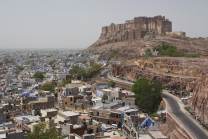Umaid Bhawan Palace
No video yet

Umaid Bhawan Palace
‹ The template Infobox building is being considered for merging. ›
Umaid Bhawan Palace, located in Jodhpur in Rajasthan, India, is one of the world's largest private residences. A part of the palace is managed by Taj Hotels. Named after Maharaja Umaid Singh, grandfather of the present owner Gaj Singh. The palace has 347 rooms and is the principal residence of the former Jodhpur royal family. A part of the palace is a museum.
Ground for the foundations of the building was broken on 18 November 1929 by Maharaja Umaid Singh and the construction work was completed in 1943.
Recently, Umaid Bhawan Palace was awarded as the World's best hotel at the Traveller's Choice Award, which was organised by TripAdvisor.
History
The history of building the Umaid Bhawan Palace is linked to a curse by a saint who had said that a period of drought would follow the good rule of the Rathore Dynasty. Thus, after the end of the about 50-year reign of Pratap Singh, Jodhpur faced severe drought and famine in the 1920s for a period of three consecutive years. The farmers of the area, faced with this hardship, sought the help of the then Maharaja, Umaid Singh, who was the 37th Rathore ruler of Marwar at Jodhpur, to provide them with some employment so that they could survive the harsh conditions. The Maharaja, in order to help the farmers, decided to build a lavish palace. He commissioned Henry Vaughan Lanchester as the architect to prepare the plans for the palace; Lanchester was a contemporary of Edwin Lutyens, who had planned the buildings of the New Delhi government complex. Lanchester patterned the Umaid Palace on the lines of the New Delhi building complex by adopting the theme of domes and columns. The palace was designed as a blend of western technology and Indian architectural features.
The palace was built at a slow pace as its initial objective was to provide employment to the famine-stricken farmers in the area. The foundation stone was laid in 1929. About 2,000 to 3,000 people were employed in its construction. Occupation of the palace by the Maharaja came after its...






